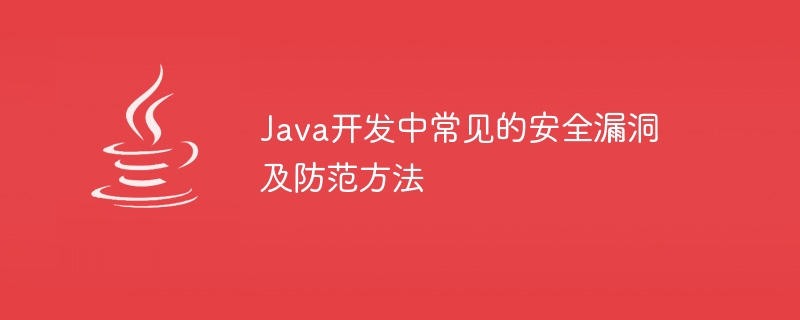

Common security vulnerabilities and prevention methods in Java development, specific code examples are required
In software development, security is a very important aspect, especially in Java is under development. As a programming language widely used in enterprise-level applications and Internet applications, Java is rich in functions and faces various potential security threats. This article will introduce several common Java security vulnerabilities and provide code examples to prevent these vulnerabilities.
SQL injection is to gain unauthorized access to the database by injecting malicious SQL commands into user input data in the application. . The following is a simple example:
String query = "SELECT * FROM users WHERE username = '" + username + "' AND password = '" + password + "'";
The above code directly splices the username and password entered by the user into the SQL query statement, making it vulnerable to SQL injection attacks. . To prevent SQL injection attacks, you can use parameterized queries or prepared statements to build SQL queries, for example:
String query = "SELECT * FROM users WHERE username = ? AND password = ?"; PreparedStatement statement = connection.prepareStatement(query); statement.setString(1, username); statement.setString(2, password); ResultSet result = statement.executeQuery();
In this way, the data entered by the user will be treated as parameters instead of being directly spliced into SQL statements, thereby preventing SQL injection attacks.
Cross-site scripting attack refers to an attacker obtaining sensitive information of users or controlling users by injecting malicious scripts into web applications. A browser attack method. The following is an example of an XSS vulnerability:
String name = request.getParameter("name");
out.println("<p>欢迎" + name + "</p>");If an attacker injects a malicious script in the parameter, the script will be executed directly on the user's browser. In order to prevent XSS attacks, you can use HTML escape functions to filter sensitive characters entered by users, for example:
String name = request.getParameter("name");
name = StringEscapeUtils.escapeHtml(name);
out.println("<p>欢迎" + name + "</p>");Through HTML escape functions, malicious scripts will be escaped into normal text, thereby avoiding XSS attacks.
Command injection means that an attacker performs unauthorized operations by injecting malicious commands into the application. The following is an example of a command injection vulnerability:
String command = request.getParameter("command");
Runtime.getRuntime().exec("ping " + command);If an attacker injects a malicious command in the parameter, the command will be executed on the server. In order to prevent command injection attacks, you can use whitelist filtering to limit the characters entered by the user and only allow legal input, for example:
String command = request.getParameter("command");
if (!isValidCommand(command)) {
throw new IllegalArgumentException("Invalid command");
}
Runtime.getRuntime().exec("ping " + command);By using whitelist filtering, only commands in the legal command list will be execution, thereby effectively preventing command injection attacks.
Summary:
In Java development, security vulnerabilities are an issue that requires great attention. This article provides prevention methods for SQL injection, cross-site scripting attacks and command injection vulnerabilities, and gives specific code examples. By taking these precautions, you can effectively improve the security of Java applications and protect user privacy and data security.
The above is the detailed content of Common security vulnerabilities and prevention methods in Java development. For more information, please follow other related articles on the PHP Chinese website!




